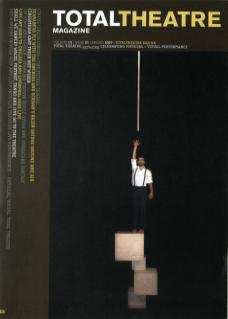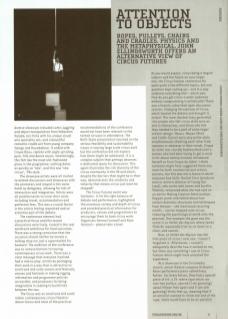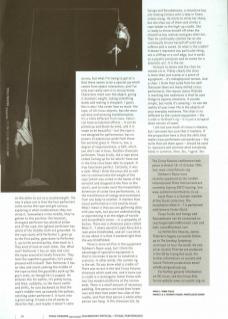As you would expect, circus being a largish subject and the future an even larger one, the Circus Futures conference hit upon quite a few different topics, but one question kept coming up – and in a way undercut everything else – which was: How do you get circus a wider audience without compromising it artistically? There was a heavily subscribed open discussion session, Changing Perceptions of Circus, which heated the debate and brought it to boil. The room divided (very generally) into people who felt circus skills were an end in themselves, and those who felt they needed to be a part of some larger artistic design. Messrs. Mason (Bim) and Cottle (Gerry) were very polite while simultaneously shooting each other from cannons or whatever in their minds. Cirque du Soleil was roundly badmouthed until a woman who had been trying to get a word in for about twenty minutes introduced herself as from Cirque du Soleil. I think someone might have suggested there was room for both commercial and artistic success, but this was not a future in which everyone had faith. Rachel Clare (producer and co-artistic director of Crying Out Loud), who works with James and Aurélia Thiérrée, reiterated what she had said on an earlier Making Creative Relationships Happen panel and talked about how certain dramatic structures and techniques from theatre – she mentioned recurring motifs – can be mapped onto circus, imposing the psychological world onto the physical. One example she gave was the scene in La Veillée des Abysses where James Thiérrée repeatedly tries to sit down on a chair, and cannot.
Now, La Veillée des Abysses was the first piece of circus I ever saw. I haven’t forgotten it. Afterwards, I couldn’t adequately describe how it worked on me, but there was something I saw at Circus Futures which might have unlocked the experience.
At a showcase in the Circomedia church, aerial theatre company Ockham’s Razor performed a piece called Every Action. For Every Action, they had a special piece of kit: a 25-metre rope which ran over two pulleys, spaced (I am guessing) about fifteen feet apart and (I am still guessing) thirty feet up, meaning that if an aerialist wanted to climb one end of the rope, there would have to be an aerialist on the other to act as a counterweight. The way it plays out is that the four performers come across the rope and get curious, exploring in what combinations they can climb it. Somewhere in the middle, they’ve gotten to this position: the heaviest, strongest performer has ahold of either end of the rope; the lightest performer has ahold of the middle; both are grounded. So the rope starts with Performer 1, goes up to the first pulley, goes down to Performer 2, up to the second pulley, then back to 1. They kind of look at each other, like, What now? Performer 1 has an idea and coils the ropes around his beefy forearms. They look like superhero gauntlets; he’s pretty pleased with himself. Then Performer 2 has an idea and starts yanking the middle of the rope so that the gauntlets yank up the guy’s arms, as though he’s a puppet. He endures this for awhile, it’s pretty funny, and then, suddenly, as the music swells and shifts, he runs backward so that the rope’s middle rises up towards the pulleys, catching under performer 2. It turns into a giant swing. It took a lot of words to describe that, and maybe it doesn’t come across, but what I’m trying to get at is that there seems to be a special joy which comes from object interaction, and I’ve only ever really seen it in circus/mime. Characters meet over the object, giving it dramatic weight, taking something dumb and making it eloquent. I guess this is why I like corde lisse so much: the rope, of all circus objects, has the most extreme and amazing transformation. It’s a little different from tissu. Fabric can have accidental effects – it can be picked up and blown by wind, and it is made to be beautiful – but the rope is not designed for performance, has no powers of expression aside from those the aerialist gives it. There is, too, a degree of responsiveness, a heft, which you don’t see in tissu. Another showcase performer, Tanya Scully, did a rope piece called Coming up for Air which I have not in the time since been able to unpack. It may have been perfect. Certainly, it was a duet. What I think the piece did so well was to communicate the weight of the rope (which was coiled in the hands of the aerialist and dropped to the floor at the start), and to make overt the kinaesthetic dimension of corde lisse performance, i.e. the transference of energy and movement from one body to another. It matters that visual performance is not exactly visual. What I mean is that you are gathering data with your eyes, but you are understanding or experiencing it on the edges of tactile and kinaesthetic sense — in a sympathy of bodies. There was a showcase piece called What if…? where aerialist Layla Rosa did a rope piece blindfolded, and all I can think to say about it is that it seemed right that she was blindfolded.
There is more artifice in the equipment Ockham’s Razor used, but I think the advantage of specialist equipment is that it can make it easier to establish a scenario. In other words, the custom rig is the set. Do you know what a cradle is? There was an act in the last Circus Futures showcase which used one, and it turns out a cradle is a rectangular metal frame with two tiny wooden platforms at the narrow ends. There is a small amount of necessary padding. One person can hook their knees over and their feet under two sides of the cradle, and from that person a whole other person can hang. In the showcase act, by Swings and Roundabouts, a shoeshine boy sits looking listless until a lady in finery comes along. He starts to shine her shoes, but she slips out of them and climbs a rope ladder to the high-up cradle. She is ready to throw herself off when the shoeshine boy realises and goes after her. Then he continually catches her as she continually throws herself off until she softens and is saved. So what is the cradle? It doesn’t represent any particular thing, not a clifftop or a roof edge, but it works as a psychic precipice and an arena for a dramatic act. It is the set.
Go back to James and the chair he cannot sit in. Pretty clearly the chair is more than just a prop or a piece of equipment – it’s metaphysical terrain. And a chair. I think that aside from his skill (because there are many skilled circus performers), the reason James Thiérrée is reaching new audiences is that he uses things to express emotions. It sounds simple, but really it’s amazing – to see the reality of your inner life in the objects of your everyday existence. The chair is no different to the custom equipment – the cradle or Ockham’s rig – it is just a stripped down version of same.
I am not sure much of circus is theatre, but I am even less sure that it matters. If the proposition here is that the skills that make circus performers extraordinary – the skills that set them apart – should be used to represent and animate what everybody holds in common, then, Yes, I agree. Yes.
The Circus Futures conference took place in Bristol 10–11 October 2006. See: www.circusfutures.org Ockham’s Razor have recently appeared at the London International Mime Festival and are currently (spring 2007) touring. See: www.ockhamsrazortheatre.co.uk Layla Rosa is a founder member of the Shunt collective. The installation What if…? is performed with Geneva Foster Gluck. Tanya Scully and Swings and Roundabouts can be contacted on reachingseraphim@hotmail.com and kats.rosen@hotmail.com La Veillée Des Abysses, James Thiérrée’s hugely successful follow up to The Junebug Symphony, continues to tour the world. He and sister Aurelia Thiérrée are produced in the UK by Crying Out Loud. For further information on current and future Thiérrée productions email info@cryingoutloud.org For further general information on UK circus, see the Circus Arts Forum website www.circusarts.org.uk


